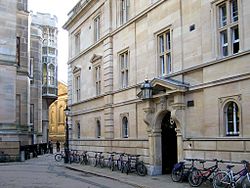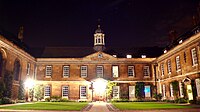Trinity Hall, Cambridge
| Trinity Hall
| |||||||||||
 Entrance to Trinity Hall on Trinity Lane | |||||||||||
|---|---|---|---|---|---|---|---|---|---|---|---|
| Master: | Mary Hockaday | ||||||||||
| Website: | trinhall.cam.ac.uk | ||||||||||
| |||||||||||
| Location | |||||||||||
| Grid reference: | TL44675849 | ||||||||||
| Location: | 52°12’21"N, 0°6’57"E | ||||||||||
Trinity Hall (formally The College or Hall of the Holy Trinity in the University of Cambridge) is a constituent college of the University of Cambridge.
Founded in 1350, Trinity Hall is the fifth-oldest surviving college of the university, having been established by William Bateman, Bishop of Norwich, to train clergymen in canon law after the Black Death.
Trinity Hall has two sister colleges at the University of Oxford: All Souls and University College.
Contents
History
The devastation caused by the Black Death in England of the 1340s included the loss of perhaps half of the population; Bishop Bateman himself lost nearly 700 of his parish priests, and so his decision to found a college was probably centred on a need to rebuild the priesthood. The site that Bateman chose was the original site of Gonville Hall, which had been founded three years earlier, but was financially struggling. Bateman's clerical aim for the Hall is reflected in the foundation of 1350, when he stated that the college's aim was "the promotion of divine worship and of canon and civil science and direction of the commonwealth and especially of our church and diocese of Norwich." This led the college to be particularly strong in legal studies, a tradition that has continued over the centuries.[1]
At first all colleges in Cambridge were known as "Halls" or "Houses" and then later changed their names from "Hall" to "College". However, when Henry VIII founded Trinity College next door, it became clear that Trinity Hall would continue being known as a Hall. The new foundation's name may have been a punishment for the college's master, Stephen Gardiner, who had opposed the king's remarriage and had endured much of the college's land being removed. It is incorrect to call it Trinity Hall College, although Trinity Hall college (lower case) is, strictly speaking, accurate. A similar situation had existed once before when Henry VI founded King's College (in 1441) despite the existence of King's Hall (founded in 1317). King's Hall was later incorporated in the foundation of Trinity College in 1546.
Trinity Hall, in addition to having a chapel, also had joint usage of the Church of St John Zacharias with Clare Hall, until the church was demolished to enable the construction of King's College in the 15th century. After this, the college was granted usage of the nearby Church of St Edward, King and Martyr on Peas Hill, a connection which remains to this day.
Buildings
The College site on the Cam was originally obtained from Bateman's purchase of a house from John de Crauden, Prior of Ely, to house the monks during their study, with Front Court being built within the college's first few decades. The mediæval structures remain unaltered, but with their façade altered to a more baroque style during the Mastership of Sir Nathaniel Lloyd in 1710-45.[2]
Chapel
The Chapel was licensed in 1352 and was built by August 1366, when Pope Urban V granted the College permission to celebrate eucharist there. Its present decor stems from its 1729–30 renovation; Lloyd had pre-existing graves removed to the Ante-Chapel, and the walls decorated with wainscotting and the ceiling with past Masters' crests. The Chapel was extended east in 1864, during which the original piscina was discovered and hidden behind a secret door. The painting behind the communion table is Maso da San Friano's Salutation, loaned from the Fitzwilliam Museum in 1957, replacing an earlier painting by Giacomo Stella.
Dining Hall
The Dining Hall was rebuilt under Lloyd along similar lines to the Chapel, with rendered walls replaced by wainscotting and mediæval beams by baroque carvings. A large portrait of Lloyd dominates the wall behind high table; Lloyd supposedly made it irremovable from its wainscot surroundings, so that his representation can never be erased from the College.
Libraries
The college library was built in the late 16th century, with the permission of Elizabeth I and probably during the mastership of Thomas Preston, and is now principally used for the storage of the college's manuscripts and rare books; it is one of the few remaining chained libraries left in the country. The new Jerwood Library overlooking the river was opened by Lord Howe in 1999, and stores the college's modern book collection.
Gallery
Outside links
| ("Wikimedia Commons" has material about Trinity Hall, Cambridge) |
References
- 'The Hidden Hall: Portrait of a Cambridge College', Peter Pagnamenta, ISBN 1-903942-31-4
- 'Trinity Hall: The History of a Cambridge College, 1350-1975', Charles Crawley, ISBN 0-9505122-0-6
- 'Warren's Book' (Ed. 1911 by A.W.W.Dale)
- 'Trinity Hall or, The college of scholars of the Holy Trinity of Norwich, in the University of Cambridge', Henry Elliot Malden. (1902). London: F.E. Robinson.
| Colleges of the University of Cambridge | |
|---|---|
|
Christ’s • Churchill • Clare • Clare Hall • Corpus Christi • Darwin • Downing • Emmanuel • Fitzwilliam • Girton • Gonville and Caius • Homerton • Hughes Hall • Jesus • King’s • Lucy Cavendish • Magdalene • Murray Edwards • Newnham • Pembroke • Peterhouse • Queens’ • Robinson • St Catharine’s • St Edmund’s • St John’s • Selwyn • Sidney Sussex • Trinity • Trinity Hall • Wolfson |
|

















